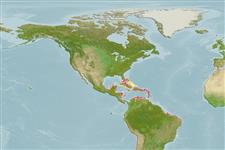Common names from other countries
Classification / Names / Names
Nombres comunes | Sinónimos | Catalog of Fishes (gen., sp.) | ITIS | CoL | WoRMS
Environment: milieu / climate zone / depth range / distribution range
Ecología
; salobre; rango de profundidad 1 - 2 m (Ref. 86836). Tropical; 25°C - 33°C (Ref. 86836)
Western Central Atlantic.
Length at first maturity / Tamaño / Peso / Age
Maturity: Lm ? range ? - ? cm Max length : 1.0 cm OT macho / no sexado; (Ref. 415)
Massive lobate to ramose. Color: dark green externally, lighter internally. Surface smooth with oscular chimneys; 0.5 - 1 cm diameter. The species is compressible but crumbly in consistency (Ref. 415).
Maximum surface diameter: 1 cm (Ref. 415). Depth range from Belize (Ref. 086836). Common on shallow reefs, seagrass beds, and mangroves (Ref. 415).
Life cycle and mating behavior
Madurez | Reproducción | Puesta | Huevos | Fecundidad | Larva
Members of the class Demospongiae are hermaphroditic. Life cycle: The zygote develops into parenchymella larva (free-swimming) before settling down on a substrate where it grows into a young sponge.
Collin, R., M.C. Díaz, J. Norenburg, R.M. Rocha, J.A. Sánchez, M. Schulze, A. Schwartz and A. Valdés. 2005. (Ref. 415)
IUCN Red List Status (Ref. 130435)
CITES status (Ref. 108899)
Not Evaluated
Not Evaluated
Threat to humans
Harmless
Human uses
| FishSource |
Herramientas
Fuentes de Internet
Estimates based on models
Preferred temperature
(Ref.
115969): 26.3 - 28.4, mean 27.4 (based on 151 cells).
Vulnerability
Low vulnerability (10 of 100).
Price category
Unknown.
